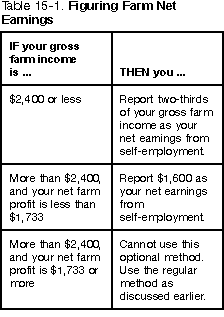| Publication 225 |
2001 Tax Year |
Methods for Figuring Net Earnings
There are three ways to figure your net earnings from
self-employment.
- The regular method.
- The farm optional method.
- The nonfarm optional method.
You must use the regular method unless you are eligible to use one
or both of the optional methods. See Figure 15-1.
Figure 15-1. Can I Use the Optional Methods?
Why use an optional method?
You may want to use the optional methods (discussed later) when you
have a loss or a small net profit and any one of the following
applies.
- You want to receive credit for social security benefit
coverage.
- You incurred child or dependent care expenses for which you
could claim a credit. (An optional method may increase your earned
income, which could increase your credit.)
- You are entitled to the earned income credit. (An optional
method may increase your earned income, which could increase your
credit.)
Effects of using an optional method.
Using an optional method could increase your SE tax. Paying more SE
tax could result in your getting higher benefits when you retire.
If you use either or both optional methods, you must figure and pay
the SE tax due under these methods even if you would have had a
smaller tax or no tax using the regular method.
The optional methods are used only to figure your SE tax. To figure
your income tax, include your actual earnings in gross income,
regardless of which method you use to determine SE tax.
Regular Method
Multiply your total earnings subject to SE tax by 92.35% (.9235) to
get your net earnings under the regular method. See Short
Schedule SE, line 4, or Long Schedule SE, line 4a.
Farm Optional Method
Use the farm optional method only for earnings from a farming
business. You can use this method if you meet either of the following
tests.
- Your gross farm income is $2,400 or less.
- Your net farm profit is less than $1,733.
Figuring farm net earnings.
If you meet either of the two tests explained earlier, use the
following table to figure your net earnings from self-employment under
the farm optional method.
Gross farm income.
Your gross farm income is the total of the amounts from:
- Line 11, Schedule F (Form 1040), and
- Line 15b, Schedule K-1 (Form 1065), (from farm
partnerships).
Net farm profit.
Net farm profit generally is the total of the amounts from:
- Line 36, Schedule F (Form 1040), and
- Line 15a, Schedule K-1 (Form 1065), (from farm
partnerships).
However, you may need to adjust the amount reported on Schedule
K-1 if you are a general partner or if it is a loss. For more
information, see Partnership Income or Loss, earlier.

Social security credits.
Since two-thirds of $2,400 is $1,600, this counts for one credit
($1,600 × $830) for social security coverage in 2001. You
cannot use the full amount of your gross income to determine credits
when you are figuring the SE tax on only two-thirds of that amount.
Optional earnings less than actual earnings.
If your farm net earnings are less than your actual net earnings,
you can still use the farm optional method. Your actual net earnings
are your net earnings figured using the regular method explained,
earlier.
Example.
Your actual net earnings from self-employment are $425 and your net
earnings figured under the farm optional method are $390. You owe no
SE tax if you use the optional method, because your net earnings under
the farm optional method are below $400.
Two or more farms.
If you operate your own farm and are also a partner in a farm
partnership, or in any way have gross farm income from more than one
farm, you must add your farm income from all farming sources to get
your total earnings subject to SE tax. If you use the farm optional
method, you must add all gross income from farming to make the $2,400
test.
Example.
Your gross income from your own farm is $600 and your distributive
share of the gross income from a farm partnership is $900. Since your
gross income from farming is less than $2,400 ($1,500), your earnings
subject to SE tax under the farm optional method are $1,000 ( 2/3 × $1,500).
Nonfarm
Optional Method
This is an optional method available for determining net earnings
from nonfarm self-employment, much like the farm optional method.
If you are also engaged in a nonfarm business, you may be able to
use this method to compute your earnings subject to SE tax from your
nonfarm business. You can use this method even if you do not use the
farm optional method for determining your earnings subject to SE tax
and even if you have a net loss from your nonfarm business. For more
information about the nonfarm optional method, see Publication 533.
 You cannot combine farming income with nonfarm income from
self-employment to figure your earnings subject to SE tax under either
of the optional methods.
You cannot combine farming income with nonfarm income from
self-employment to figure your earnings subject to SE tax under either
of the optional methods.
Using Both Optional Methods
If you use both optional methods, you must add together the net
earnings figured under each method to arrive at your total net
earnings from self-employment. You can report less than your total
actual net earnings from farm and nonfarm self-employment. If you use
both optional methods, you cannot report more than $1,600 of your
combined net earnings from self-employment.
Previous| First | Next
Publication Index | IRS-Forms Main | Home
| 